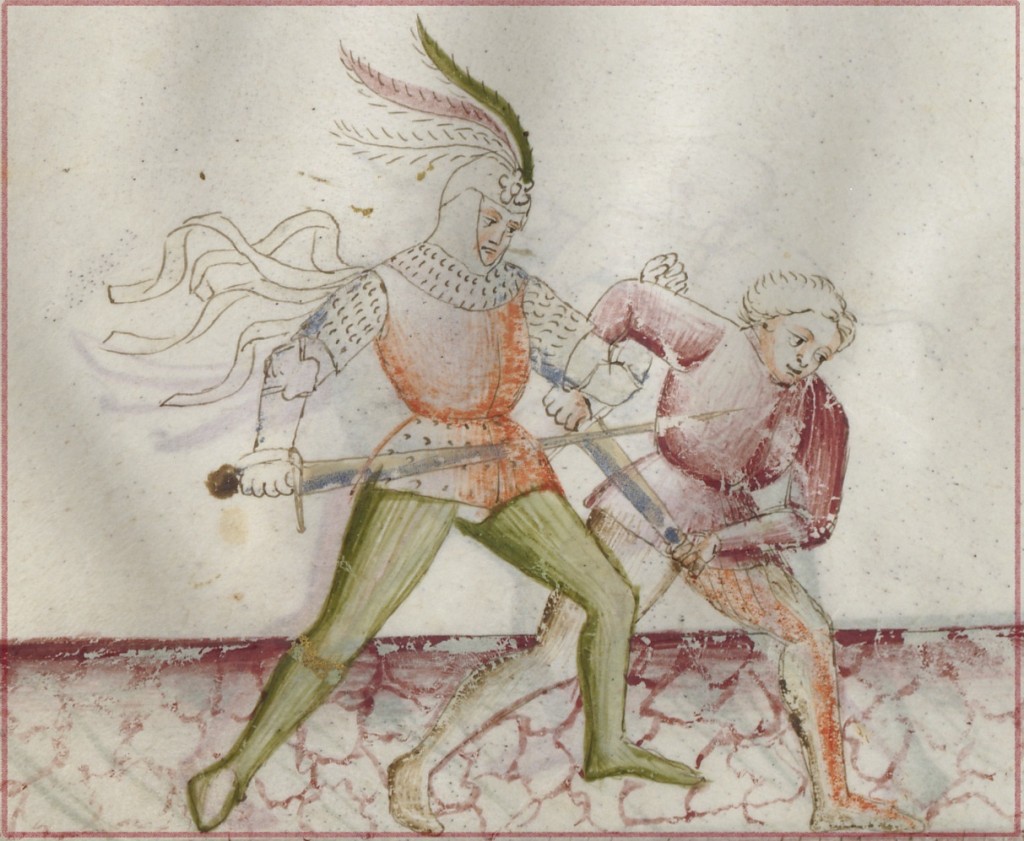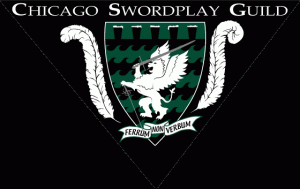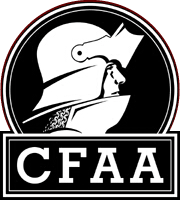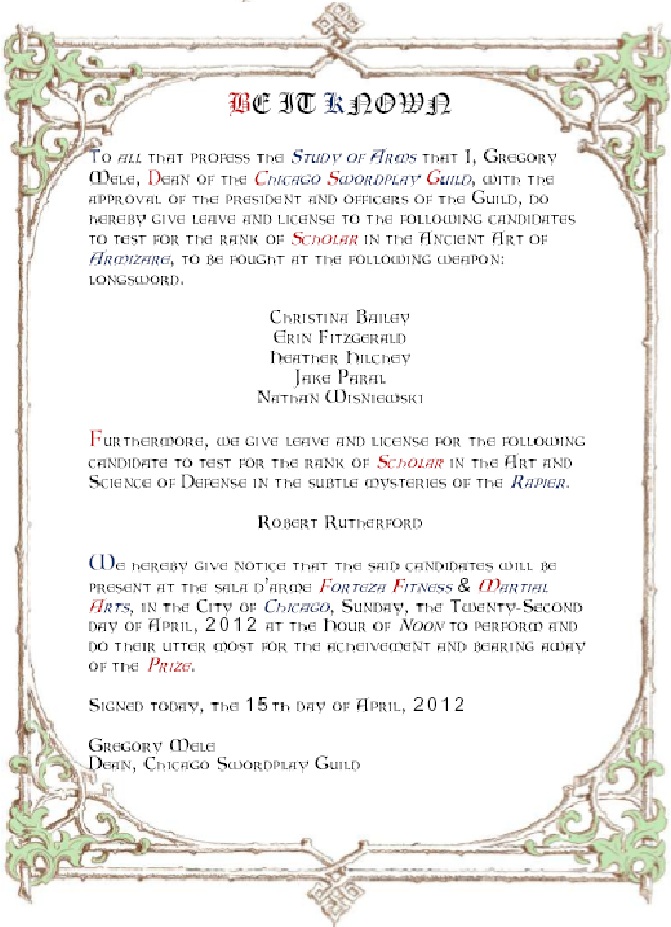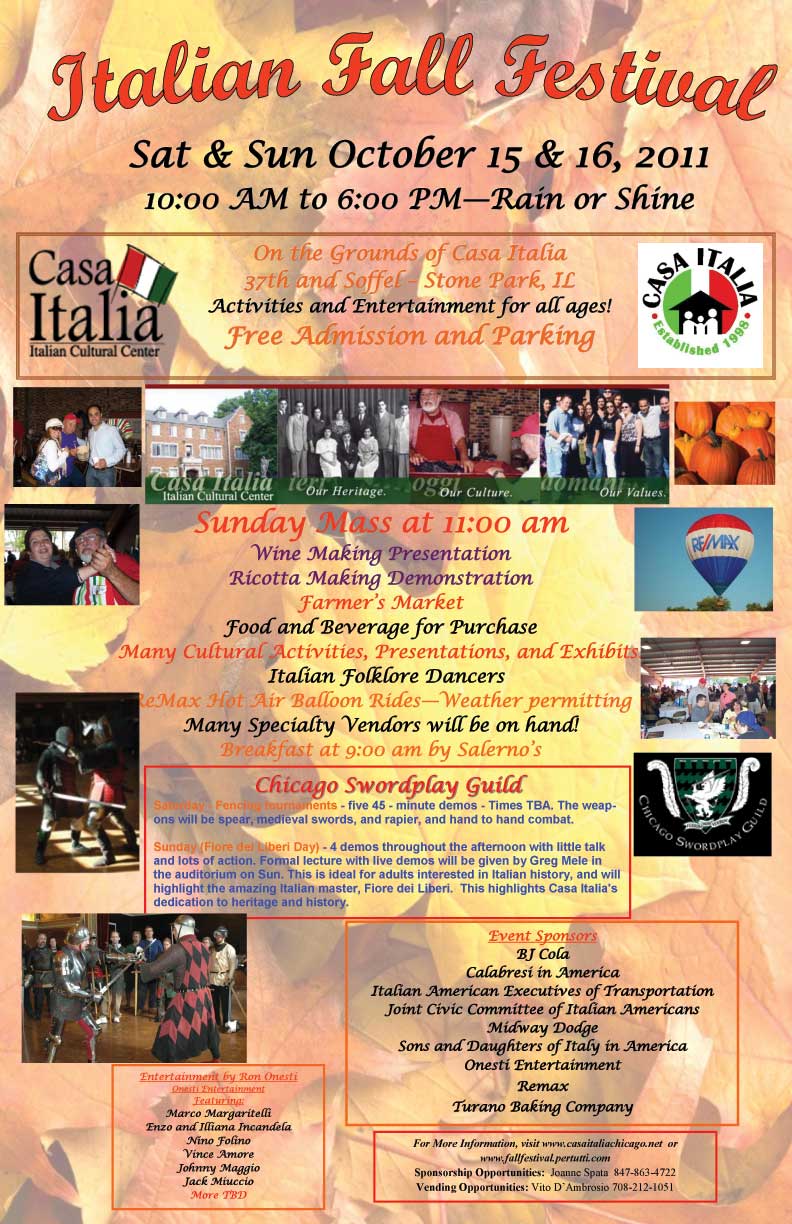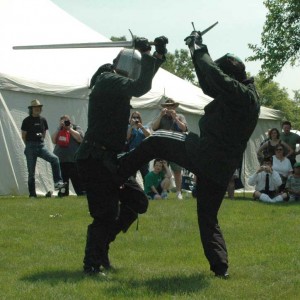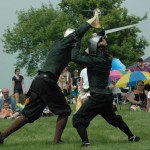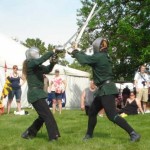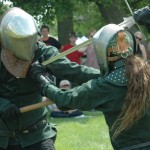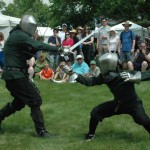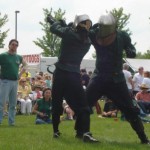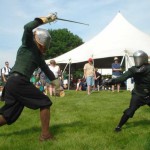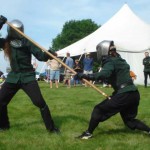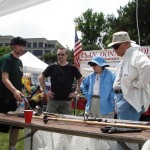
This past weekend (actually, for the last five days), Forteza had the privilege of hosting Roberto Laura for an immersion in the world of Italian folk arts. For those who do not know Maestro Laura, after many years in traditional Asian arts, he has spent the last twelve years traveling back and forth from Germany to Italy to research, document and train in traditional Italian arts. I first became aware of his work from some internet forum posts by Tony Wolf, and then, about two years later was introduced by our mutual friend, Jorg Bellinghausen. Since Jorg was also responsible for recommending Roland Warzecha and Christian Eckert, I’ve learned to instinctually trust his opinions on what makes for a good martial artist.
This rather long review will give readers some sense of the arts themselves (I hope), as well as how they feel to a long-time student of Italian medieval and Renaissance martial arts.
PROLOGUE
From my first discussions with Roberto, he was friendly and open, explaining the nature and history of his arts, including that while many of them have traditional histories that are said to go back to the Middle Ages, as peasant traditions, none can truly be documented before about 1700, and all have obviously added, refined or adapted their curriculum over the years (for example, the introduction of boxing strikes in some lineages during the ’20s, or the introduction of more Asian style kicks in the ’70s). I was extremely impressed by Roberto’s dedication to a) preserving these arts, some of which only have one or two living teachers, b) documenting both their legendary and verifiable history and c)his dedication to track the alterations and evolutions of the art, and to faithfully transmit the art as his teachers have given it to him, but also to maintain knowledge of the traditional elements that may have been changed.
Sadly, there are many people who learn of a dead or dying martial art and graft its history and a few of its moves to a related Asian art they already know and “presto” they are a Spanish, Italian, Native American, even an Atlantean martial artist. Sometimes, this is painfully obvious (anyone ever seen Stav?), but other times a good fighter and salesman with just enough of something new can be successful selling snake oil. So, I am always cautions and skeptical, without being cynical.
Then I saw video of what Roberto taught. This sure as hell was *not* Filipino martial arts, nor even savate and la canne with Italian names. It was something else, and the guards, movements and sensibilities of the knife work had a “feeling” that was reminiscent of Bolognese swordsmanship, the stick was uncannily like a left-handed version of Fiore dei Liberi’s two-handed sword. NOT identical, but related in movement, tactics and footwork – much like you might think of how unarmoured sword might influence unarmoured staff; or more to the point, how the same *culture* might think about using such a weapon.
Roberto does not teach martial arts for a living, nor does he intend to do so, so he is fairly conservative about how often he travels abroad to teach. Fortunately, Jorg told him that we weren’t nutters, so when I asked him to come teach, he not only agreed to do so, but agreed to come early so that the Forteza instructors could really try to get down the basics of the system.
DAYS ONE AND TWO – PRIVATE TRAINING

Nicole Allen opened her magnificent Victorian home with its private sala d’arme to be Roberto’s home in Chicago, where he was joined by our dear friend Sean Hayes from the Northwest Fencing Academy. Nicole’s sala was where we all gathered to begin training. Roberto told us that we would start with the Scuola Cavalieri d`Umiltà or the Knights of Humility. This school derives from Manfredonia, Apulia (by tradition, from the 15th century). It is a highly elegant fighting system with the knife, shepherd’s staff and the razor. The footwork is circular and precise, using both an open and closed body position. (Armizare students – to understand the closed position, just think Fiore’s sword in one hand – it is identical.). The instruction includes two solo forms – one for each direction you walk the circle, and a series of partner training exercises, as well as a variety of specialized tactical instruction. Training begins with “la scuola”, which focuses on the use of the knife in the formal duel and then “la strada” – fighting in all contexts.
We spent a great deal of time learning the first form and its partnered applications. I can’t really explain in words how elegant the movement is – when you see video it seems florid, with hops or jumps that seem “dancey”. Then you see how they are used, and how they are meant to counteract the limitations of a knife – as Silver said, it cannot form sure wards. A knife is even worse than a dagger, as it has no guard, so you have to learn how to manage distance carefully, as well as how to thrust without running your own hand on the blade.
Officially, we were learning the first form and the basics of its application, both “la scuola” and “la strada”. In reality, we were learning how to move and how to *think* like an Italian knife-fighter.
Take away lesson of day one – fighting a knife duel with an 18″ knife is scary as hell. Second lesson – compared to Roberto, I move like a drunken baboon.
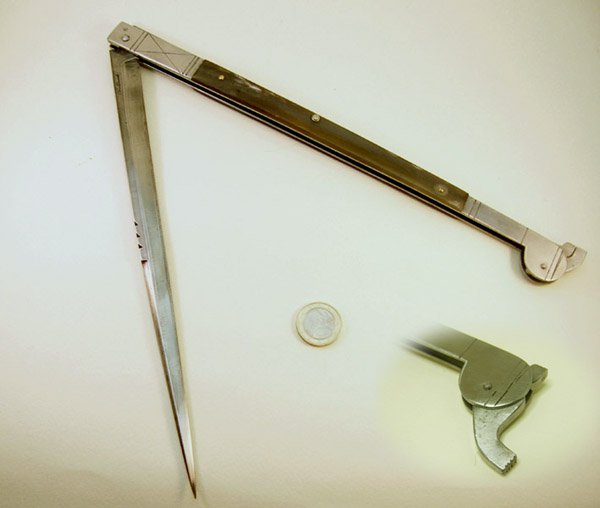
On Day Two, we brought Roberto to Forteza, and showed off our little sala like proud papas. Then we got to work. First we reviewed Day One and then Roberto began to show us a new system: Scuola Fiorata- The Flowery School, from Calatabiano, Sicily. The weapons taught within this traditional dueling art are the shepherd stick and the knife. This lesson also gives a great insight into how living traditions evolve and change, because the Fiorata is technically a modern school, yet in many ways it is a return to older sensibilities. The school comes from a very old – and still living – tradition called the Scuola Rutatu (Circling School), but after WWII some masters of the system were concerned with the loss of close-fighting techniques and a transition to fast, but smaller, less powerful actions. They worked to create a new school that would counter Rutatu, producing a system which combines the elements of open and closed guards, dynamic assaults and unites the knife with the stick – the guards, blows, etc are *identical*.
We ended formal training on Day Two with Roberto giving us an historical discussion on the traditions: how the Flowery School was born and showing a comparison between it and the old school; explaining weapons and techniques that are known to have existed but which have been lost, and then discussing the traditions of knife dueling in southern Italy. The Cavalieri school was taught by both common people and the Camora, and he showed how the Camora used the dueling system in a series of multi-level initiations, which were like a combination of English Prize Play and Masonic initiation (except Masons didn’t sometimes use their ceremonies as a way to “whack” the candidate!).
Exhausted and happy, we did what we do best at the CSG – headed off to a favorite pub, to initiate Roberto and Sean in the mysteries of bacon-popcorn.
Take away lesson of day two – there is vast amount of martial culture and history that is still alive in southern Italy, but fading, and it is crucial not to let it be forgotten. Second lesson – compared to Roberto, I move like a drunken baboon.
DAYS THREE AND FOUR – SEMINAR
We had about seventeen people for the actual seminar, including three of my students from the Rocky Mountain Swordplay Guild. Sean, Keith, Trey, Jesse and I were tapped to be “teaching assistants” for Roberto, although it just reminded us of how green we really were.

The first day was Fiorata knife, a beautiful style (truly flowery), that also is clearly “fencing”. As I had noted with the Cavalieri school, this style uses what we think of as “classical” Renaissance Italian footwork: passes, inquartate, intagliate, girate, etc. It also has certain tactical sensibilities that are identical to advise of the Bolognese masters – such as playing from the left in what we might call guardia porta di ferro e stretta. Not to sound like Inigo Montoya, but if you have studied your Agrippa, Fabris or Manciolino, in the Fiorata school are not just the same *types* of actions, but the very same, if we consider a knife versus a sword.
To end the day’s training, Roberto introduced us to la Scuola Cielo e Meraviglia (the School of Heaven and Its Marvels) which also comes from Apulia, and is about two-hundred years old. This is a close-quarter fighting system which uses grips, joint locks, throws. As very old traditions these schools use a wide variety of daggers and folding knives, including cloak and dagger techniques and improvised weapons. Roberto made it clear that he is only a student of this tradition, and that he was introducing us to his current understanding of the system a passed to him by his teacher.
Although a younger tradition than either the Calvieri school or the roots of the Fiorata tradition, for historical martial artists, this tradition “feels” more like what we see in the medieval traditions: a direct, no-nonsense system of self-defense that also uses a variety of close-combat techniques and finishing moves. It is absolutely fascinating. Here is a short video clip that will give you some small feel for the tradition:
Finally, Roberto took mercy on all of us, and we adjourned to the Fountainhead for wonderful food and drink, and we fed our teacher polenta ala americana. His San Remo sensibilities were actually very impressed with the mix of crab and polenta, so I breathed a sigh of relief. I drove everyone back to Il Castello di Nicoletta and we had a little gelato to end the night at about 10 PM….but then Roberto had a few more things he wanted to show Sean and I…..

I came away from day three with a much deeper understanding of how the Italian knife masters conceptualize the fight – things that seem like gymnastics for gymnastics sake, flowery purely for the sake of elegance, or restrictive because of the rules of “la scuola” – the first level of the training – all have sound martial, pedagogical or biomechanical principles. It also is some of the most beautiful “poetry in motion” I have ever seen, like a mixture of flamenco, tarantella and classical fencing. Second lesson – compared to Roberto, I move like a drunken baboon.
Day Four
Our fourth and final day was the Fiorata stick, and I truly am in love with this weapon. It is fast, powerful and although it has some resemblance to French baton, to me it is much more like a relative of the Japanese jo, the Italian longsword and the English and German staff (although as a shorter weapon, it lacks the ferocious power of the quarterstaff, which I still think may be one of Europe’s deadliest weapons in the hands of a master).
Roberto says that he is not as adept at the bastone as he is the knife, and if this is the case, then a master who specializes in the bastone must be a sight to behold! The weapon is not very heavy (although there is another school, the Royal School, who uses a weapon as thick as a man’s wrist!), which means it be wielded with great speed and, like a sword, swiftly change from one line to another. As the Fiorata school sees knife and stick as one art, the training on day three made day four much easier as we worked on the first form – an extremely long form, and only one of four.
I can’t begin to describe how much the stick feels like longsword done by a lefty. There are obvious differences – like using positions that have the arm has a shield for the head so that if you miss a defense, your weak arm takes the blow – something you can’t do against a sword. Likewise the stick strikes are the knee, hand or head only – against, because a stick is not a sword, nor is there a guard to defend the hands.
But having said that, the similarities are profound: the use of volta stabile and tutta volta, not just in principle, but in form; the use of a left leg lead while striking from the right side to create a bind; etc. Also, the guards are familiar: posta di finestra, posta di donna on both sides, but also posta di donna la soprana (used for more power, and to fight against multiple opponents), tutta porta di ferro and coda longa. When transitioning to fight close, the positions are primarily posta di vera croce, posta sagitarria and posta serpente lo soprano. Of course, there are only so many ways to wield a lever arm, but then you look at the tactics – like throwing thrusts from what we would call posta di donna (by “lifting the arms over the head”, and not the way most Fioreists think Fiore means that – Roberto’s way works much better).
The southern schools also all claim that their arts began in Spain, and here is where the pedagogy gets interesting. Although the long solo forms, or assalti, are modern, they are comprised of shorter tactical forms called “lines” or “rules”. One begins from the salute – done by starting with the staff point down, as if holding an armpit height sword with its point on the ground – and kicking it into guard, just as is done with the Iberian montante. Some of these rules include: fighting in a narrow corridor, fighting in a very narrow passage, fighting multiple opponents in an open place and fighting where four streets meet. Anyone who is familiar with Iberian swordplay recognizes at least three of those scenarios. The techniques aren’t quite identical, but they are very, very close. So close I started slipping into the wrong system a few times…

FINAL THOUGHTS
Roberto was born in Italy but grew up in Germany, which means that he teaches with a German work-ethic; ie: we trained until we had to either eat or fall over, ate, and then trained until dinner, had a leisurely dinner where we wrote down terminology and took notes, then often did a little light training when we got home until it was time to collapse into bed so we could train again. It was mind-blowing, exciting, and exhausting, and between my notes and a dozen hours of video I hope I can keep it all straight. When everyone left on Sunday, Roberto asked that we not go out, but order dinner in, so the core students could train more – he wanted to make sure that he was leaving us with enough understanding to train on our own. So, after introducing him to Chicago-style pizza we took to the floor for a final two hours, as he assigned us to which schools he thought we should each focus on first. In the end, we really only stopped because the students simply could no longer differentiate a quacciatura from a calamari.
This seems like a long review, but it is only a touching of the surface. If it seems like I am gushing, it is because I am. This was the best martial arts training I have had …. possibly ever.
First lesson – there is a wealth, no, a treasure hoard of knowledge in these folk arts for anyone who calls himself an historical Italian martial artist, so much so that I will from now on think of my work with Armizare and Bolognese swordplay as BR and AR – before I met Roberto, and after I met Roberto. Put another way, if you study Armizare or Renaissance swordsmanship and do NOT take the opportunity to see what these traditions hold, and the oral teachings that a living tradition can provide about stance, body movement, etc, you are doing yourself a serious disservice. Just as there are a handful of old boxers and Catch wrestlers who are custodians of a wealth of knowledge for English martial artists, the rural and often “backward” nature of southern Italy has allowed it to keep alive arts that I am truly convinced come from the same family as the more patrician arts we seek to recreate.
Second lesson – compared to Roberto, I move like a drunken baboon.
Final lesson – even if that first lesson was not true, the Cavalieri and Fiorata schools are traditional martial arts of such great beauty, elegance and sophistication, deeply tied to the land and culture of their birth, that I will take every opportunity to study them, not just to help my HEMA studies, but to make sure that they continue into the next generation.

